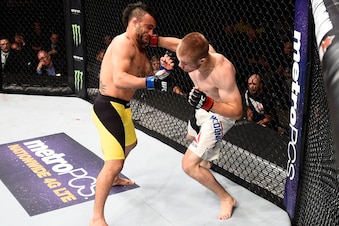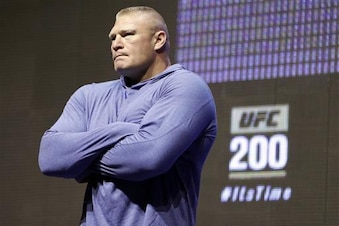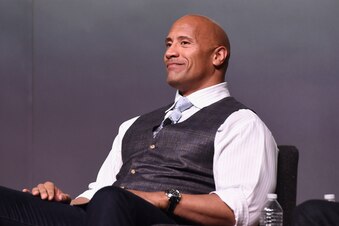This has to be the best tv series in india right now
Famous quotes
"Happiness can be defined, in part at least, as the fruit of the desire and ability to sacrifice what we want now for what we want eventually" - Stephen Covey
Saturday, October 22, 2016
Saturday, October 01, 2016
Why is the UFC worth 4bn$
Here is the explanation from Bleacher report
When the announcement finally came that the UFC had been sold after weeks of speculation, the $4 billion price tag entertainment agency WME-IMG paid for it raised eyebrows around the sporting world.
It's the largest sale of a sports franchise in history, easily topping the $2 billion former Microsoft CEO Steve Ballmer paid for the Los Angeles Clippers in 2014. It's even more than the current valuation of the Dallas Cowboys, Real Madrid, FC Barcelona, the New York Yankees and Manchester United, according to Forbes, though there's a good chance any of those organizations would top the UFC's sale price in the current market.Why was WME-IMG willing to pay a record-setting price for the UFC?
On the most basic level, it's because the UFC is already a tremendously profitable company. According to various investment metrics such as enterprise value (EV), earnings before interest, taxes, depreciation, and amortization (EBITDA) and forward-revenue multiples, per Bloody Elbow's Paul Gift, the UFC stacks up favorably compared to both other sports franchises and the entertainment industry writ large.
 NIKLAS HALLE'N/Getty Images
NIKLAS HALLE'N/Getty Images
Fight Pass now features major fights like Anderson Silva vs. Michael Bisping.
It's safe to say WME-IMG didn't buy the UFC for its current value, however, but because it thinks the UFC is a growing business moving forward. It has a plan, or a series of plans, to maximize the UFC's revenue.
Leaving aside the issue of expansion into the enormous Chinese market or other international development plans, along with projected growth from Fight Pass, there are two major areas where WME-IMG expects to make its paper on the UFC deal: the next domestic TV contract and growth in pay-per-view revenues.
The 2016 version of the UFC offers its consumers two different products.
On the one hand, it's a TV sport like the NFL, Major League Baseball, the NBA or the NHL, which spreads its tentacles across a major-network platform (Fox) and then smaller outposts (Fox Sports 1 and occasionally Fox Sports 2). Shoulder programming, like The Ultimate Fighter or UFC Reloaded, appears on a variety of related family networks, such as Fox Deportes and the regional Fox Sports affiliates.
 Jeff Bottari/Zuffa LLC/Getty Images
Jeff Bottari/Zuffa LLC/Getty Images
Six hundred thousand people tuned in on a Wednesday night to watch a Fight Night held in Sioux Falls, South Dakota.
There are still bumps in ratings for premium fighters. Per Dave Meltzer of Wrestling Observer Newsletter and MMA Fighting, Dominick Cruz's return against TJ Dillashaw in January was the second-highest-rated show in Fox Sports 1 history, after the Conor McGregor-Dennis Siver Fight Night card the year before.
In general, however, the UFC's ratings on Fox Sports 1 are remarkably stable. Per Meltzer, its June Fight Night card featuring Rory MacDonald vs. Stephen Thompson and not much else, and which happened to air starting at nearly 11 p.m. on the East Coast, still drew nearly a million viewers.
These ratings have risen over the course of the Fox deal to their current level. There's no real reason to think they'll drop, and they speak to a durable base of fans who know and consume the UFC as a TV product.
On the other hand, the UFC is still a pay-per-view business. Its premium content, in the sense of its best and best-known fighters, can be found only when consumers fork over $59.99 to watch via their cable provider or through one of many online options, including UFC TV and PlayStation or Xbox apps.
Pay-per-view isn't the same business in 2016 that it was in 2010, when the vast majority of the UFC's content and revenue had to be consumed through that model. On paper, the business isn't much smaller now: The UFC sold 7.55 million units in 2015, compared to a record 8.805 million back in 2010, despite spreading its name fighters across a multitude of different platforms and networks now.
The major difference lies in whom, exactly, consumers are buying on pay-per-view.
 John Locher/Associated Press
John Locher/Associated Press
Brock Lesnar was the UFC's biggest draw in 2010.
Compare that to 2015. Last year, McGregor and Ronda Rousey, by far the promotion's two biggest draws, headlined five of the 13 events and combined to sell 61 percent of the year's total.
In other words, the UFC is more dependent than it has ever been on a small contingent of stars to sell its pay-per-views. The trend is clear, obvious and runs directly from Lesnar and St-Pierre in 2010 to Anderson Silva and St-Pierre in 2013 to McGregor and Rousey now.
 John Locher/Associated Press
John Locher/Associated Press
Fans tune in for McGregor.
WME-IMG can grow both the TV product and the pay-per-view product in distinct ways.
The TV product is more straightforward. The UFC signed a seven-year deal with Fox in 2011 that at the time was reported to pay the promotion somewhere north of $100 million per year. By the standards of sports broadcast deals in the recent past, this is a steal of epic proportions.
As we discussed, the UFC's audience is real, it's stable and it tunes in for practically everything. Take the week of July 11-17 as an example: Half of Fox Sports 1's top programming came from the UFC. A mediocre Fight Night card on a Wednesday came in just behind a Kansas City-Detroit baseball game, that card's preliminaries cracked the top five and a replay of the main card clocked in at number seven.
The UFC's value to Fox is undeniable. What's even more striking is how little it costs.
In the age of the DVR and cord-cutting, live sports broadcasts are one of the last bastions of live TV viewership, with all the value that implies for advertisers. The enormous TV contracts sports organizations have received in the last decade reflect this value.
Between Fox and NBC, for example, NASCAR's current TV package is worth a staggering $915 million per year by way of a series of deals signed in 2012 and 2013. While the Los Angeles Dodgers' current exclusive deal with Time Warner has been an "unmitigated disaster," per Jeff Passan of Yahoo Sports, it's still worth $332 million per year over its 25-year life.
The smaller-market Seattle Mariners signed an agreement worth nearly $118 million per year in 2013 but also own a majority of their regional sports network, which pushes the deal's true value to somewhere in the range of $150 million per year.
The NFL's 2011 renewal of its agreements with Fox, CBS and NBC dwarfs them all, coming in somewhere in the range of $3 billion per year. When combined with its deals with DirecTV, NFL Network and its radio partners, the league's annual media revenue is around $7 billion.
Every team, then, receives around $200 million per year before accounting for gate receipts, concessions, jersey sales and every other form of revenue.
This is the landscape in which the UFC will be signing a new TV deal.
Its current $115 million annual deal looks like a paltry sum by comparison, though it was a good deal at the time, and it has provided tremendous value for both the UFC and Fox. The UFC has matured into a TV property and built its core audience, while Fox has received a tremendous amount of cheap programming to build a base for its fledgling Fox Sports 1 network.
The UFC certainly had this on its mind when it went up for sale. According to Michael Smith and John Ourand of SportsBusiness Journal, the numbers the UFC supplied to potential buyers projected its next media deal's annual worth at around $400 million, a nearly fourfold increase from its current agreement.
WME-IMG has a ton of experience in negotiating these deals. After all, it represented the UFC in the 2011 negotiations that produced the Fox agreement in the first place.
There might not be smooth sailing into a landmark new rights deal, though. The sports media landscape is changing rapidly as more and more consumers cut the cord. ESPN has lost more than 10 million subscribers since 2013, and each of those subscribers is worth $80 per year to the company.
ESPN played a huge role in driving the value of these rights deals through the roof with agreements like its $130 million annual fee to the collegiate Southeastern Conference, and now it's losing the enormous, lucrative subscriber base that made those deals possible.
This dynamic is happening with every media group as more and more consumers ditch their cable packages for Netflix, Amazon Prime, HBO Now and the WWE Network, but nobody has been hurt more than ESPN.
This is a problem for the UFC, which presumably hoped to have ESPN as an interested bidder in its next rights deal, and $400 million annually might be wishful thinking. Still, even in the shrunken landscape that succeeds the current sports-media bubble, the value of its TV deal will increase dramatically.
The UFC is the biggest player in a growing sport that reaches a coveted demographic, and somebody will be willing to pay for access to it.
Despite the uncertainty in the current market for TV rights deals, this aspect of WME-IMG's purchase of the UFC is straightforward: The TV deal will be up in a couple of years, and the next one will be worth much, much more than the current agreement. This is what most analyses of the sale have focused on, and with good reason.
The less appreciated aspect of the sale is its contribution to the UFC's other major product, pay-per-view.
We're living in the era of the celebrity fighter, as Bleacher Report's Jonathan Snowden memorably termed it. While the TV product is stable and reliable, stars sell pay-per-views, not the UFC brand.
It's easy to forget in all this talk about the media landscape and TV rights deals, but WME-IMG is at heart a talent agency.
What do talent agencies do? They build stars.
 Dan Steinberg/Associated Press
Dan Steinberg/Associated Press
Ari Emanuel in 2015.
"One of the smartest things Ari and Patrick did was to incentivize collaboration," Shapiro said. "You're incentivized to push business to other areas of the company."
In an excellent and comprehensive piece, MMAjunkie's Ben Fowlkes reported at length on this aspect of WME-IMG's business:
Now WME-IMG represents athletes, actors and musicians. It handles licensing and marketing for more than 200 college sports teams. It owns an e-sports league and a bull-riding organization. It has negotiated TV deals for European soccer and Indian cricket leagues. It runs Fashion Week events all over the globe, and represents several top models and designers. It owns the Miss Universe pageant, which it bought from former client and current Republican presidential nominee Donald Trump. It represents Oprah Winfrey and Dwayne "The Rock" Johnson.
 Ilya S. Savenok/Getty Images
Ilya S. Savenok/Getty Images
WME-IMG has played a role in makingDwayne Johnson a legitimate star.
Placing individual entertainers or athletes across multiple platforms is the essence of the talent side of WME-IMG's business. That's how you build stars—repeated exposure to mass audiences. It worked for the UFC with Rousey and McGregor, but as successful as it's been with those two, its in-house public relations and marketing operations can't touch what WME-IMG is capable of.
The math is simple. More than ever, pay-per-view audiences are buying stars, and WME-IMG has all the tools necessary to create them.
Whether WME-IMG understands how to pick and choose its potential breakout talents and what connects them to MMA's audience and the fringe of the mainstream that might also buy in is another story. At least on paper, though, the fit between a UFC that's increasingly in the business of selling celebrities and a parent company that excels at making and polishing celebrities is seamless.
Will the WME-IMG purchase be good for the UFC in the long run?
These kinds of initiatives would undoubtedly help to grow the UFC as a whole, but they would also have the specific effect of creating more fighters consumers are willing to pay for. There's a direct connection between this star-building operation and a more lucrative UFC.Whether all of this will come to fruition or not remains to be seen. In the abstract, however, WME-IMG is uniquely placed to maximize the UFC's value.
Patrick Wyman is the Senior MMA Analyst for Bleacher Report and the co-host of the Heavy Hands Podcast, your source for the finer points of face-punching. He can be found on Twitter and Facebook.
An excerpt from 4 hour work week
An American businessman took a vacation to a small coastal Mexican village on doctors orders. Unable to sleep after an urgent phone call from the office the first morning, he walked out to the pier to clear his head. A small boat with just one fisherman had docked, and inside the boat were several large tuna. The american complimented the Mexican on the quality of the fish.
"'How long did it take for you to catch them ? the American asked.
Only a little while
Why dont you stay out longer and catch more fish
I have enough to support my family and give a few to friends
But.... W'hat do you do with the rest of your time
I sleep late fish a little play with my children take a siesta with my wife Julia and stroll into the village each evening where i sip wine and play guitar with my amigos. I have a full and busy life senor.
Sir Im a Harvard MBA and can help you. You should spend more time fishing and with the proceeds buy a bigger boat.I no yime you could buy bigger boats with larger hauls .Ebentually you will have a fleet of fishing boats
Instead of selling your catch to the middleman you would sell directly to the customers eventually opening your own cannery You would control the product processing and distribution.You would need to leave this small coastal village and move to Mexico city or Los angeles where you could run the expanding enterprise with proper management.
But senor how long will all this take ?
15-20 years. 25 tops
But what then senor?
Thats the best part, when the time is right you would announce an IPO and sell your company stock to the public and become very rich.You would make millions
Millions senor? Then what?
Then you would retire and move to a small coastal village where you could sleep late ,fish a little, play with your children,take a siesta with your wife , and stroll into the village in th'e evenings where you can play guitar with 'your amig'os............oh wait
"'How long did it take for you to catch them ? the American asked.
Only a little while
Why dont you stay out longer and catch more fish
I have enough to support my family and give a few to friends
But.... W'hat do you do with the rest of your time
I sleep late fish a little play with my children take a siesta with my wife Julia and stroll into the village each evening where i sip wine and play guitar with my amigos. I have a full and busy life senor.
Sir Im a Harvard MBA and can help you. You should spend more time fishing and with the proceeds buy a bigger boat.I no yime you could buy bigger boats with larger hauls .Ebentually you will have a fleet of fishing boats
Instead of selling your catch to the middleman you would sell directly to the customers eventually opening your own cannery You would control the product processing and distribution.You would need to leave this small coastal village and move to Mexico city or Los angeles where you could run the expanding enterprise with proper management.
But senor how long will all this take ?
15-20 years. 25 tops
But what then senor?
Thats the best part, when the time is right you would announce an IPO and sell your company stock to the public and become very rich.You would make millions
Millions senor? Then what?
Then you would retire and move to a small coastal village where you could sleep late ,fish a little, play with your children,take a siesta with your wife , and stroll into the village in th'e evenings where you can play guitar with 'your amig'os............oh wait
Labels:
4 hour work week,
harvard,
mba,
mexican siesta,
Timothy Ferriss
Subscribe to:
Posts (Atom)
